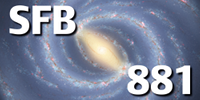See the Universe as Astronomers do
 Spectrum
of μ Leo, a metal-rich red giant star
Spectrum
of μ Leo, a metal-rich red giant star
“See the Universe as astronomers do” – a film by Heidelberg scientists brings the most exciting discoveries about planets, stars, and the Galaxy directly to the public.
Scientific conferences are market places of ideas, and a key driver of scientific progress and innovation. But usually they are closed events, where scientists remain among themselves. Not so with the international scientific conference “Frontiers of Stellar Spectroscopy” in Heidelberg, co-organized by astronomers of SFB 881 in early 2015. Here, scientists at the MPIA, ZAH, and Haus der Astronomie, along with the colleagues from the University of Cambridge, teamed up with professional filmmakers and students of Heidelberg University to produce a documentary film that brings the most exciting new discoveries about planets, stars, and the Milky Way directly to the public – and makes science accessible to everyone, out in the open.
The film tells about stars in the universe, their role in developing life, in hosting exo-planets, and in building up our own Galaxy. Project director Maria Bergemann explains: “In our films, we will explore some of the key questions of our existence. In the words of Carl Sagan, 'we are star stuff' – the chemicals that make up our bodies were produced in stars. If we want to understand our own origins, then we need to understand the chemistry of stars. Also, the central star is the key to the possibility of life in a distant solar system. Are habitable planets like the Earth ubiquitous, or are they a fluke? We can only answer that question if we know more about the stars within our galaxy.”
The film is comprised of seven short episodes, which are available online (YouTube and Vimeo) and on a bi-lingual DVD in German and English, which will be distributed for free. “We want people of all ages to watch the films. For our yougest audience, 6-10-year-olds, we also made two exciting cartoons to explain what a star is”, says Bergemann.
A number of key questions on both stellar chemistry and life-friendly conditions in distant solar systems have had to wait for the advent of today's giant 10 m Earth-based telescopes, sophisticated computer technology for simulations, and space missions such as the Gaia mission launched in late 2013. The films explores these new technologies as well as the human side of astronomical research.
More information under:
http://sfb881.zah.uni-heidelberg.de/education-outreach.html
http://www.mpia.de/explore-our-universe
http://www.mpia.de/entdecke-unser-universum


